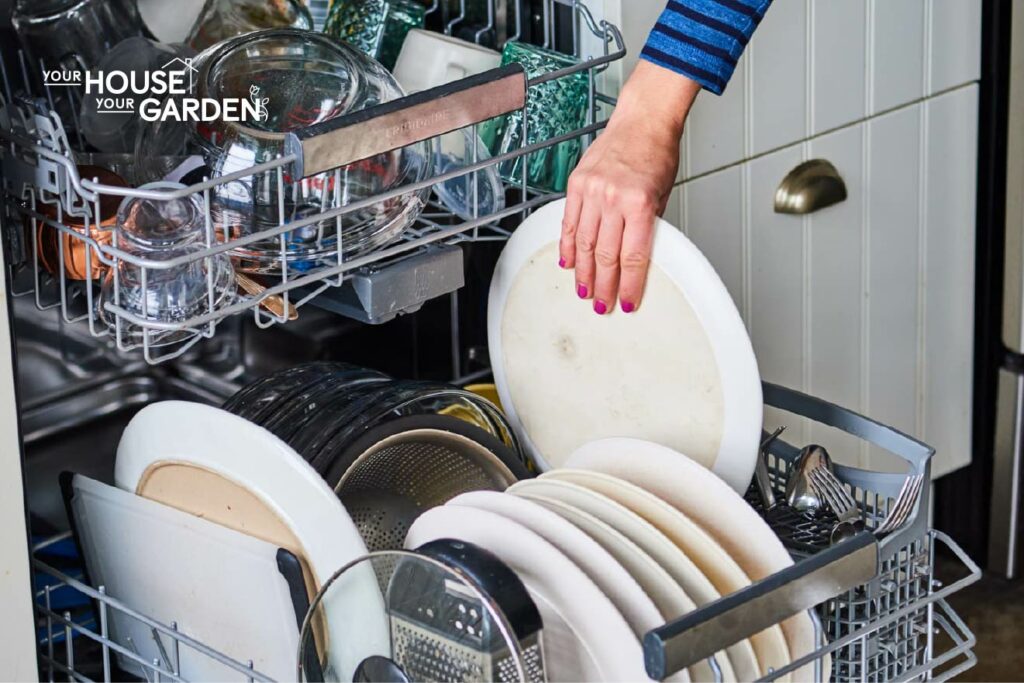Using a dishwasher involves the following steps: Rinsing any remaining food scraps off the dishware, loading the dishware into the dishwasher racks, loading the dishwasher with detergent, closing the door, choosing a cycle, and pressing start.
What is a dishwasher? Dishwashers are large home appliances used to automatically clean dishware, cookware, and cutlery. Dishwashers are a convenient alternative to handwashing and are found in over 60% of American households, making them one of the most popular home kitchen appliances.
If you would like to learn more about how to work a dishwasher, refer to our detailed dishwasher usage guide below.
1. Rinse Off Food Scraps
Everything you put in the dishwasher should be rinsed clear of any remaining food scraps before being loaded into the racks. If you don’t, the food scraps have a tendency to collect and harden inside cups and on cutlery.
Moreover, you don’t want to overload the dishwashers filter. Not only can this reduce performance, but it can cost you extra money on filters or repairs in the long run.
2. Load Dishes Into the Racks
Most dishwashers come with an upper and lower rack. The upper rack is used to house cups, bowls, and other small dishware items. Large cooking utensils, like spatulas or stir sticks, can also be loaded into the top rack.
The lower rack is designed for plates, pots, and other large items. The lower rack is usually outfitted with a small plastic housing unit for cutlery.
When loading items into the dishwasher, make sure there’s space between them. If you stack plates up against each other, there is a good chance food particles will become stuck between them. Additionally, when loading cups and other glassware, always have the opening facing down.
If you load cups with the opening facing up, food particles will begin to pool, and when the dishwasher cycle has finished, you’ll be left with a small amount of dirty water at the bottom of each glass.
Finally, when loading cutlery, always load them with the handle side down. If you load them in the opposite direction, there’s a good chance they won’t be cleaned properly.
3. Load Dishwasher With Detergent
Once the dishwasher is full and you’re ready to run a cycle, it’s time to load the appliance with the proper detergent. Dishwashers require specially formulated soaps/detergents that are capable of breaking down oils, grease, and tough food residue.
Some dishwasher soaps come in bar form while others come as a thick liquid. Regardless of which model you have, all dishwashers are built to handle both.
If you’re wondering which option works best, know that liquid detergent mixes better with water. Additionally, bar soaps don’t always break down all the way, and you’ll sometimes find a sand-like coating on some of your dishware.
When buying soap, consider purchasing one with a rinse additive. Rinse additives reduce the appearance of white spots that people often find on glassware after running a dishwasher cycle.
4. Close the Door and Choose a Cycle
Next, close the dishwasher door and choose a cycle on the control panel. Although it varies from dishwasher to dishwasher, the most common cycles include:
Normal: The most basic and commonly used option. A normal cycle will take anywhere from two and half to three hours to complete and is the best all-around option.
Quick Wash: If your dishes aren’t very dirty, or you want to cut down on water usage, the quick cycle is a good option. The average quick wash cycle takes around one hour and a half to complete.
Heavy Duty: Designed for large pots and pans that are covered in grease or oil. This cycle is the longest and most energy intensive option, but also the most thorough. A Heavy Duty wash can take up to four hours to complete.
Pre Wash Cycle: If you have plates and other dishware with tons of caked-on food, a pre-wash cycle can help. Essentially, this cycle soaks your dishes before starting the normal cleaning cycle. If you don’t want to scrub your dishes to remove caked on food debri, this is an excellent feature.
Sanitize: When chosen, the sanitize setting increases the water temperature during the regular rinse/wash cycle to further sanitize your dishware.
Extended Dry: Select this option when you want to increase the drying time on any cycle.
Of course, some dishwashers come with upwards of 12 cycle options. If your model falls into this category, we strongly recommend reading the user manual to understand what the different options do.
5. Close Door and Press Start
When you’ve chosen the appropriate cycle, close the door, press start, and wait for the cycle to end. Depending upon which cycle you chose, the dishwasher can take anywhere from 40 minutes to six hours to finish washing your dishes.
6. Unload Dishes
The last step involves unloading the dishwasher. If you find there’s too much food or soap residue, consider running an additional rinse cycle. However, if the food has become hard and caked on to your plates, a rinse cycle won’t do the trick. Instead, run a soak cycle or a quick wash cycle.
Dishwasher Using Tips for Efficiency and Better Cleaning
When using a dishwasher, there are a few tips and tricks you can follow to improve overall efficiency, the most important being:
Avoid Hard Water: Hard water, meaning water that’s full of minerals, is tough on dishwashers. The minerals tend to wear on the parts and greatly reduce their lifetime. If you live in a place with hard water, consider installing a hard water filter in the intake valve.
Don’t Overload: Overloading the dishwasher with too many dishes will reduce its efficiency.
Clean the Dishwasher Trap: The trap is where food debris is collected. If not emptied regularly, it can fill up, meaning no new food particles can be collected. When this occurs, the efficiency of your dishwasher is reduced.
Run An Empty Cycle With Vinegar: If you toss a cup of vinegar into the bottom of the dishwasher and run it on a normal cycle (without any dishes in it), the vinegar will clean and sanitize your dishwasher.

Main Steps for Dishwasher Usage
Using a dishwasher can be broken down into the following steps:
- Rinsing dishes and loading them into the dishwasher.
- Loading the dishwasher with soap/detergent.
- Choose the appropriate cycle (some of the best dishwashers come with 10+ cycle options)
- Press start.
Does the Dishwasher Type Affect the Usage Stages?
No, the dishwasher type doesn’t affect the usage stages. That said, it’s still work examining the most popular dishwasher types:
Built-In Dishwashers: Built in dishwashers are built into your countertop and use their own water hookup. Typically, an appropriately sized section of the countertop is cut away to make room for the dishwasher.
Drawer Dishwasher: Instead of having a single door, Drawer Dishwashers have two slide out drawers. These types of dishwashers are most commonly found in large kitchens where plenty of space is available.
Top Control Dishwasher: With Top control dishwashers, the control panel is located at the top of the door, meaning they aren’t seen when the door is closed. Top control dishwashers don’t add any functional advantages over normal dishwashers but some people find them more stylish.
Portable Dishwashers: Unlike regular dishwashers, portable dishwashers aren’t installed in place, meaning they can be moved around. Portable dishwashers often come with wheels and a detachable water hook up, allowing you to run a cycle then move it into storage.
When To Prefer Dishwasher Over Dishdrawer
Dishwashers are preferable to Dish Drawers when you want to save money. The average traditional dishwasher model is cheaper than a DishDrawer. That said, DishDrawers have two separate compartments capable of running their own, independent, cycle.
When it comes to the question of Dishwasher vs. Dishdrawer, there’s no clear winner and there are pros and cons to both.
Alternative Uses of a Dishwasher For Other Uses Besides Washing Dishes
Although dishwashers are designed for washing dishes and other kitchen ware, they can be used for a variety of other functions. To learn more about the different dishwasher uses, refer to the sections below.
Use A Dishwasher As A Drying Rack
To use a dishwasher as a drying rack, follow these steps:
- Open the dishwasher door and pull out the rack.
- Place plates, cups, and other dishware on the racks.
- Leave the door open and let the dishes dry.
You could also load up the dishwasher with clean, but still wet, dishes and run a quick dry cycle.

Use A Dishwasher As A Dish Storage Cabinet
To use a dishwasher as a dish storage cabinet
- Make sure the inside of the dishwasher is clean and sanitized.
- Place whatever dishes and cookware you wish to store into the racks.
- Close the dishwasher door.
When using the dishwasher as a storage unit, you must ensure the dishwasher is clean and free of any water or moisture. If it isn’t mold and bacteria can begin to grow, which can leave your dishware with an unpleasant smell.
Use A Dishwasher As A Shoe Cleaner
To use a dishwasher as a shoe cleaner, follow these steps:
- Remove as much dirt and debris by hand as you can.
- Remove inserts from inside the shoe.
- Place shoes on the top rack.
- Select a cycle that uses NO heat and doesn’t have a drying process.
- Place a mild dish soap (free of bleaching agents) into the soap dispenser.
- Close the lid and press start.
Leather boots and shoes should not be washed in the dishwasher, only sneakers or runners. Moreover, dishwashers can also ruin your shoes, so be careful which cycle and soap you use.

